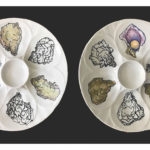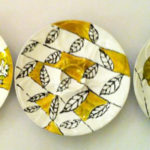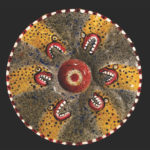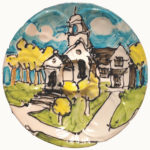Oyster plates were a Victorian-era idea that became part of the evolution of oysters from inexpensive street food to coveted delicacy, a shift that happened in the early 1900s, when overfishing and pollution made them suddenly scarce.
Antique versions were designed for serving shucked oysters — each one placed in a fanciful porcelain version of a shell. More modern renditions of oyster plates have wells deep enough to cradle the bivalves on the half shell. Deeper wells are best for serving half shells over ice. Most are made just big enough to balance an oyster steady in its precious liquor. Usually, they include a small bowl in the center for dips and sauces. While the number and pattern of wells can vary, most plates hold six oysters. While that number seems dainty by Wellfleet standards, oyster plates old and new have become collectors’ items.
This week, Wellfleet Preservation Hall showed us some favorite designs hand-painted in years past for the Hall’s “Oysterfete,” an evening of food, wine, and art that celebrated the local harvest and raised money for year-round programming at the hall.
Anyone could decorate a plate for the event, but the challenge seemed to especially attract artists. Oyster plates turned out to be “a fabulous way to showcase the work of the amazingly talented artists in our community,” says Janet Lesniak, Preservation Hall’s executive director. “We can’t wait to do it all again.” Here are some to tide you over until next year.







